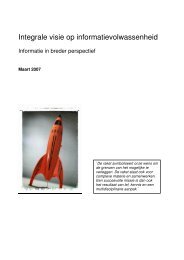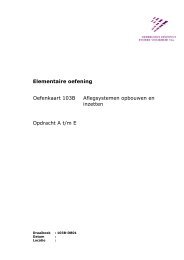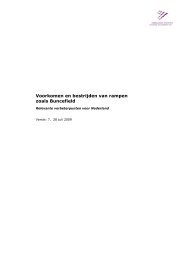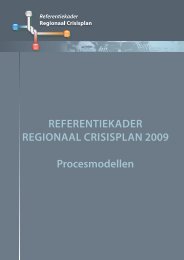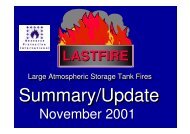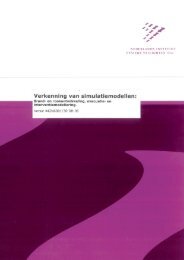fixed or semi-fixed foam fire protection systems for storage tanks - NIFV
fixed or semi-fixed foam fire protection systems for storage tanks - NIFV
fixed or semi-fixed foam fire protection systems for storage tanks - NIFV
- No tags were found...
Create successful ePaper yourself
Turn your PDF publications into a flip-book with our unique Google optimized e-Paper software.
The amount of water and the flow rate needed toproduce 3% <strong>foam</strong> solution to generate <strong>foam</strong> tofight a large tank <strong>fire</strong> can be found in Table 1.The quantity of 3% <strong>foam</strong> concentrate and the flowrate needed to produce 3% <strong>foam</strong> solution togenerate <strong>foam</strong> to fight a large tank <strong>fire</strong> can befound in Table 2.COOLING INVOLVED TANK AND THE PRO-TECTION OF ADJACENT TANKS FROM RADI-ATED HEAT SOURCEtank <strong>fire</strong> could be expected to fully involve aneighb<strong>or</strong>ing identical tank in approximately 1.5hours under the following conditions.- 4 m/sec.(14 km/hr.) wind towards neighb<strong>or</strong>ingtank- intertank separation of 0.5 diameter(82 ft.) (25 m)- neighb<strong>or</strong>ing tank having pontoon roof andinadequate water spray <strong>protection</strong>Altering any of the above conditions can changethe time f<strong>or</strong> ignition of the adjacent tank:With reference to existing guidelines, the amountof water needed to cool the involved tank shell isestimated by tank size:Base CaseChange of conditions:= 1.5 hrs.100 ft. (30 meter) diameter 750 gpm (3m 3 /min.)120 ft. (36 meter) diameter 1000 gpm (4m 3 /min.)160 ft. (48 meter) diameter 1250 gpm (5m 3 /min.)220 ft. (67 meter) diameter 1500 gpm (6m 3 /min.)Cooling water required to protect each adjacenttank not shielded from the tank on <strong>fire</strong> is 500 gpm(2 m 3 /min.).In practice water applied to the shell of a largetank on <strong>fire</strong> is ineffective in preventing it frombuckling and def<strong>or</strong>ming. In the late stages ofextinguishment, cooling water applied on the areaabove the liquid level would help the <strong>foam</strong> stay incontact with the tank shell. The cooling streamsshould be stopped when <strong>foam</strong> attack has startedto conserve water and to concentrate on extinguishment.The need f<strong>or</strong> protecting adjacent <strong>tanks</strong> can bestbe illustrated with inf<strong>or</strong>mation and data publishedin a recent study done on large tank <strong>fire</strong>s.Although not yet fully validated it neverthelessprovides valuable inf<strong>or</strong>mation f<strong>or</strong> pre-<strong>fire</strong>planningpurposes.The time required to create an escalation conditionin an adjacent tank depends upon a numberof fact<strong>or</strong>s including: tank size, separation, type,initial boiling point of flammable liquid in the <strong>tanks</strong>,water cooling, tank design, wind speed anddirection.F<strong>or</strong> example, a full surface <strong>fire</strong> involving a 164 ft.(50m) diameter open top, floating roof naphthaCalm (no wind condition)= 2.8 hrs.Intertank separation increased to 1.0 D (50 m)= 3.0 hrs.Intertank separation increased to 2.0 D (100 m)= 17.0 hrs.Water <strong>protection</strong> on side facing exposure= 2.8 hrs.Double deck roof on exposed tank= 1.5 hrs.Water <strong>protection</strong> on side facing exposure +double deck roof= 24.0+hrs.Tank diameters only 30 m but with 0.5 Dseparation = 0.5 hrsNeighb<strong>or</strong>ing tank contains kerosene, not naphtha= 22.0 hrs.Some conclusions drawn from the results are:−−−−−escalation is likely f<strong>or</strong> unprotected <strong>tanks</strong> ofvolatile material with n<strong>or</strong>mal separation unlessthe <strong>or</strong>iginal <strong>fire</strong> is extinguished quicklycalm conditions only delay the escalationpotentialincreased separation alone only delays theescalation potentialwater spray <strong>protection</strong> <strong>or</strong> roof insulation alonedoes prevent escalationwater spray and roof insulation together areeffective− smaller diameter <strong>tanks</strong> at n<strong>or</strong>mal separationare at greater risk of escalation than largerdiameter tank− lower volatility fuels provide m<strong>or</strong>e responsetime f<strong>or</strong> <strong>fire</strong> fighter





